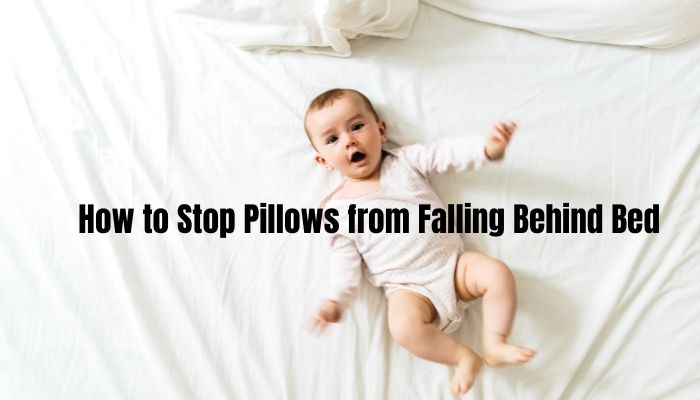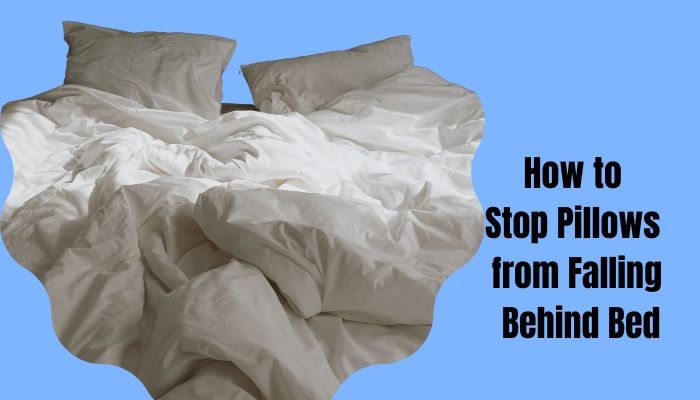Say goodbye to the pillow gap! Our expert tips will help you stop pillows from falling behind your bed, improving comfort & sleep quality. Find out more!
Why Do Pillows Fall Behind the Bed? Understanding the Problem
Picture the scenario: you’ve just made yourself comfortable, sinking into the warm embrace of your soft bed. However, when you find the perfect spot, your trusty pillow takes an unsolicited leap into the abyss behind your bed. An all-too-common predicament, the enigma of falling pillows frustrates countless individuals. It’s time to uncover why pillows persist in this unruly behavior.
The descent of pillows behind the bed is no coincidence but a consequence of several factors: the angle of your headboard, your sleep position, the pillow’s material, and the bed’s positioning against the wall. Understanding this seemingly trivial yet vexing problem makes you one step closer to ensuring an uninterrupted, restful night.
Factors That Lead to Pillow Slippage
Bedroom furniture design, particularly the angle of your headboard, plays a significant role in the rebellious dive of pillows. A headboard with a steep angle encourages pillows to slide down, seeking the path of least resistance. Moreover, the space between the bed and the wall allows room for pillows to slip into the abyss.
Sleep positions also contribute to pillow slippage. The human tendency to move during sleep can inadvertently push the pillow into the no-man’s-land behind the bed. Restless sleepers or those who prefer to sleep near the edge of the bed may experience this more frequently.
Pillow materials are another crucial component. Smooth or silky pillowcases like satin or polyester provide a slippery surface that allows pillows to glide more effortlessly. Furthermore, pillows with less structure or firmness can fold and squeeze into small spaces, leading to the dreaded drop.

Impact on Sleep Quality and Comfort
The fallen pillow isn’t just an annoyance; it significantly affects the quality of your sleep and overall comfort. You are disrupting the sleep cycle to retrieve the lost pillow, resulting in erratic sleep patterns, less restful sleep, and potential grogginess the next day. It also creates an imbalance in your sleeping posture, which can cause neck or back pain over time.
Proven Methods to Stop Pillows from Falling Behind Your Bed
Thankfully, there are tried-and-true methods to curb your pillows’ exploratory instincts.
Employ a Headboard Cushion: Installing a cushion on your headboard can reduce the angle that encourages pillow slippage. It also adds a layer of comfort while preventing pillows from sliding into the void.
Leverage Bed Positioning: Position your bed flush against the wall. This reduces the gap between the bed and the wall, leaving no space for the pillows to fall into.
Use Non-Slip Pillowcases: Swap silky pillowcases with more grip material like cotton or flannel. The less slippery surface helps keep your pillow in place throughout the night.
Use Larger Pillows or Body Pillows: Bigger or body pillows are harder to lose behind the bed due to their size. Moreover, they offer additional comfort and can assist in maintaining a healthy sleep posture.
Invest in a Pillow Barrier or Pillow Stop: These are special devices designed to keep your pillows from falling off the bed. They’re beneficial for those who move a lot during sleep.
Read more about How To Stop Sliding Down Wedge Pillow?
Optimal Pillow Placement Tips
Proper pillow placement is vital to prevent falling pillows, as well as for achieving maximum comfort. The following advice:
- Pillow Centering Aim to keep your pillows away from the bed’s edge. A centralized position offers less opportunity for pillows to slide off.
- Stack Pillows Horizontally: Stack Pillows horizontally if you use more than one pillow. This arrangement creates a broader base and prevents individual pillows from slipping.
- Utilize Pillow Shams: Shams are not just for decor; they can help keep your pillows in place. The extra layer can provide friction, discouraging slippage.
Using Bed Accessories to Secure Your Pillows
Enhancing your bed with specific accessories can help secure your pillows:
- Bed Rails: They serve as protective barriers to prevent pillows from falling off. Bed rails are particularly beneficial for restless sleepers.
- Headboard Shelf: A shelf installed on the headboard can be a physical barrier and prevent pillows from slipping.
- Bed Wedges: These are triangular aids that you can place at the head of your bed to prop up your pillows, reducing their likelihood of slipping.
The Role of Pillow Selection and Size
The type and size of your pillow can significantly impact its tendency to fall. Consider these tips when choosing your pillows:
- Opt for Larger Pillows: Larger pillows have less chance of slipping into small gaps. They also offer better support for your neck and spine.
- Choose Firmer Pillows: They maintain their structure better and are less likely to squeeze into small spaces.
- Select the Right Material: A pillowcase made of grippy material like cotton or flannel can help prevent your pillow from sliding.
DIY Solutions to Prevent Pillow Slippage
- Utilize Anti-Slip Mats: These mats, used underneath area rugs, can be put beneath your pillow to create friction and minimize movement.
- Create a Pillow Wall: If your bed isn’t against a natural wall, make a makeshift one using a long, thin body pillow. This “pillow wall” can prevent other pillows from falling off.
- Sew in Straps: Consider sewing straps onto your pillowcases if you’re handy with a needle and thread. These straps can then be tied to the bed frame, securing the pillows.
Implementing these tips and solutions can drastically reduce the chances of pillows falling behind your bed, ensuring you enjoy a more restful and uninterrupted sleep.
Crafting a DIY Headboard Buffer
A DIY headboard buffer serves as a practical solution to counter the issue of pillows falling. It adds a soft barrier that keeps the pillows in place while increasing comfort. Here’s a simple guide:
- Choose the Material: Foam, sponge, or a large, flat pillow make excellent buffers. The size should match your bed’s width.
- Cover the Material: Use a non-slip fabric, like cotton or flannel, to cover your buffer. This prevents the buffer itself from sliding off.
- Secure the Buffer: Attach the buffer to the headboard using solid and durable straps or adhesive velcro. This ensures the buffer stays in place, offering a secure barrier for your Pillows.
Pillowcase Hacks for Better Grip
Enhance the grip of your pillowcases with these hacks:
- Use Non-Slip Fabric Spray: This spray is typically used for rugs but works effectively on pillowcases too. Spray the back of your pillowcase to increase its grip.
Sew on Silicone Strips: To give your pillowcase more traction, you can sew on silicone strips similar to those used in strapless bras.
- Designs made using fabric glue: You can use fabric glue to make designs on the reverse of your pillowcase. Once dry, these patterns offer additional friction to prevent slippage.
Read more about How To Sleep On A Wedge Pillow After Shoulder Surgery?
Enhancing Your Sleep Environment for Improved Comfort
Improving your sleep environment is critical to prevent pillow slippage and enhancing overall comfort:
- Regulate Bedroom Temperature: Maintaining an optimal room temperature, typically around 60-67 degrees Fahrenheit, encourages better sleep. Too much heat can cause sweating, which can make your pillowcases slippery.
- Proper Bed Placement: Align your bed correctly against a solid wall. This eliminates the gap that pillows can fall into.
- Invest in Good Quality Bedding: High-quality bedding, such as a firm mattress and supportive pillows, prevents slippage and promotes better sleep.
Taking control of your sleep environment and making these minor adjustments can prevent pillow slippage, enhancing overall sleep quality and comfort.
The Importance of Bed and Pillow Maintenance
Consistent bed and pillow maintenance plays an integral role in enhancing your sleep quality and keeping pillows in place:
- Regular Cleaning: Regularly wash and dry your pillows and bedding to keep them in their best condition. Dust and oils can slippery pillows and pillowcases, increasing the chance of slippage.
- Pillow Fluffing: Regularly fluff your pillows to maintain their shape and firmness. Flat or lumpy pillows are more likely to slip behind the bed.
- Mattress Rotation: Rotating your mattress every 3-6 months can prevent sagging, creating slopes that encourage pillow slippage.
Reassessing Your Sleep Setup Regularly
Your sleep setup isn’t something to be fixed once and forgotten. It’s crucial to reassess it regularly for optimal comfort and to prevent pillows from falling:
- Monitor Pillow Performance: Keep track of your pillows’ tendency to slip and adjust your solutions as needed.
- Consider Comfort: What’s comfortable one month may not be the next. Regularly reassess your comfort level and make necessary changes.
- Check for Wear and Tear: Regularly inspect your pillows, mattress, and bedding for signs of wear and tear that could affect their performance.

FAQ: Preventing Pillows from Falling Behind the Bed
- Why do my pillows keep falling behind my bed?
Pillows tend to slip due to factors like the headboard’s angle, the pillowcase’s material, your sleep position, and the gap between the bed and the wall.
- How can I stop my pillows from falling?
You can prevent pillow slippage by adjusting your bed and pillow setup, using non-slip pillowcases, employing bed accessories, and implementing DIY solutions.
- Does the type of pillow I use matter?
Yes, the type of pillow can influence its tendency to slip. Firmer, giant pillows made with grippy materials are less likely to fall behind the bed.
Conclusion: The End to Pillow Displacement Woes
Pillow slippage is a common problem disrupting many people’s sleep. However, with the proper understanding and implementation of practical solutions, it’s a problem that can be managed. From the type of pillows you choose to your bed setup, each element is critical in ensuring your pillows stay where they should be.
With these tips and insights, you can end the pesky problem of falling pillows, enhancing your overall sleep quality and comfort.
